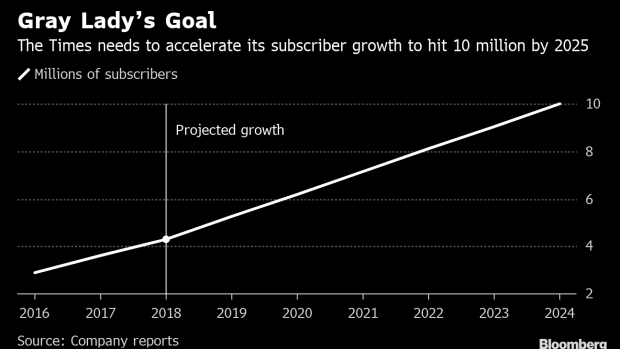Feb 22, 2019
New York Times Subscriber Hunt Sends Gray Lady to Middle America
, Bloomberg News

(Bloomberg) -- After introducing a paid cooking app more than a year ago, New York Times executives noticed something unexpected: Many of its subscribers came from rural America.
The newspaper, long synonymous with city living and coastal elites, had found a way to reach people in the middle of the country -- through their stomachs. The discovery showed that the 167-year-old publication might be able to change its image, while vastly increasing growth targets for subscribers.
“We tend to have a subscriber base broadly that’s skewed to urban areas,” Times Chief Operating Officer Meredith Kopit Levien said in an interview. “The interesting thing about cooking is its audience and subscriber base tend to be the opposite.”
With thousands of recipes (including the controversial pea-filled guacamole), NYT Cooking has more 120,000 subscribers. That remains a small sliver of the company’s overall base, but it’s where those people live that’s important -- especially if the Times wants to reach its lofty new goal of 10 million subscribers by 2025.
Even after posting better-than-expected growth last quarter, the company has a herculean task ahead. Reaching 10 million customers would more than double its current total of 4.3 million.
Achieving that goal means scouring the globe for subscribers, and changing the typical profile of a New York Times reader. It’s also going to be a costly hunt.
Already, the Times has transcended its hometown. Two years ago, California surpassed New York as the Times’ largest U.S. market for digital subscribers. The company’s executives now see opportunities to add customers in two other big states: Texas and Florida.
‘The Weekly’
A major piece of the strategy is a new TV show, “The Weekly,” which debuts in June on the Hulu streaming service and the FX network. The cable channel, which Walt Disney Co. is currently acquiring from 21st Century Fox Inc., is available in roughly 90 million homes.
The Times had other suitors for the show, but it chose FX and Hulu because they’re distributed in places where there aren’t many Times subscribers. “One of the appeals was the idea that we could bring the New York Times into homes that we wouldn’t have been in to begin with,” Kopit Levien said.
Overseas readers are another big target. About 16 percent of Times subscribers currently reside outside the U.S., and English-speaking countries like Britain, Canada and Australia offer ripe opportunities for growth. The paper even has a handful of subscribers in Antarctica.
Every Country
“There isn’t a country on the planet that doesn’t potentially have prospects for us,” Times Chief Executive Officer Mark Thompson said in an interview.
But the Times’ subscriber push will be expensive. The paper is eating into short-term profits by spending more on marketing and journalism. It’s also luring customers with discounts of as little as $1 a week, or 75 percent off, and hoping they stick around when the price goes up.
Times executives say they expect the company to remain profitable, partly by hiking prices on digital customers this year for the first time. But the publisher has entered a new phase, spending heavily now to find more paying readers -- and promising bigger profits in the future.
The Times spent nearly $50 million on marketing last quarter, about 50 percent more than a year ago. It’s been pouring money into ads like its “The Truth is Worth it” campaign, which included TV commercials.
Paywall Tinkering
Meanwhile, the Times has been quietly tweaking its paywall. While most non-subscribers only get five free Times articles a month, the publisher has experimented with giving them more access if they register online with an email address. That allows the Times to market to them more effectively, making them more likely to subscribe.
Attracting subscribers is one thing, but keeping them is another. The Times is looking for new ways to make the newspaper a daily habit. For instance, people who subscribe to multiple Times newsletters are more likely to keep paying, according to Kopit Levien.
The biggest breakthrough has been offering discounts for longer periods of time. While the Times has long offered promotions like 50 percent off for a few weeks, it has been adding more subscribers by extending those offers for a year, Thompson said.
‘Very Encouraged’
For now, Wall Street approves of the Times’ strategy. Earlier this month, after the company reported quarterly earnings, JPMorgan Chase & Co. analyst Alexia Quadrani lowered her profit estimates, citing the higher spending next quarter. But she maintained a buy rating on the stock, saying she was “very encouraged” by the subscriber growth.
The shares are up 44 percent this year, trading near a 13-year high.
Doug Arthur, an analyst at Huber Research, also is bullish -- even though he only expects 9 million subscribers by 2025, not 10 million. That growth will likely be driven partly by non-news subscription services, such as cooking and crosswords. Together they added 93,000 subscribers last quarter, up from 60,000 the quarter before. The news is where the real money is, though. NYT Cooking costs $4.99 a month. A basic digital news subscription costs about $15 a month.
“I’m in favor boosting subscriber numbers as fast as you can,” said Arthur, who has a buy rating on the stock. “Once you get someone used to paying and it’s an automatic payment on the credit card, they just forget about it.”
To contact the reporter on this story: Gerry Smith in New York at gsmith233@bloomberg.net
To contact the editors responsible for this story: Nick Turner at nturner7@bloomberg.net, Rob Golum
©2019 Bloomberg L.P.





